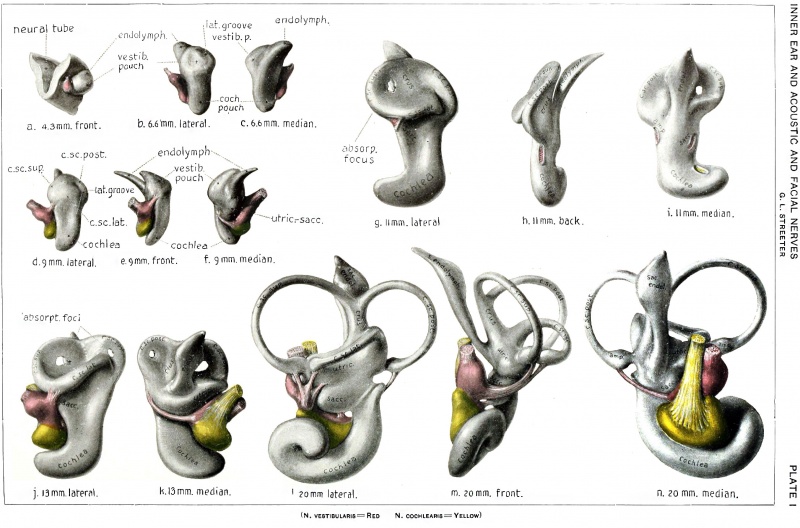File:Streeter1906 plate01.jpg

Original file (2,708 × 1,786 pixels, file size: 701 KB, MIME type: image/jpeg)
Description of Plates I
The drawings for Plates I and II were prepared under the guidance and assistance of Mr. Max Brodel.
| The reproductions shown. on these plates represent different views, in most cases lateral, front, and median, of seven selected models showing the membranous labyrinth and acoustic complex reconstructed from the following human embryos: No. 148, 4.3 mm.; No. *17, 6.6 mm.; No. 163, 9 mm:; No. 109, 11 mm.; No. 175, 13 mm.; No. 22, 20 mm.; Plate 2 - No. 86, 30 mm.
The colors, yellow and red, are used to indicate respectively the cochlear and vestibular divisions, and in general nerve flbers can be distinguished from ganglion cell masses by their lighter tone.
|
The following abbreviations are used:
|
| Historic Disclaimer - information about historic embryology pages |
|---|
| Pages where the terms "Historic" (textbooks, papers, people, recommendations) appear on this site, and sections within pages where this disclaimer appears, indicate that the content and scientific understanding are specific to the time of publication. This means that while some scientific descriptions are still accurate, the terminology and interpretation of the developmental mechanisms reflect the understanding at the time of original publication and those of the preceding periods, these terms, interpretations and recommendations may not reflect our current scientific understanding. (More? Embryology History | Historic Embryology Papers) |
- Mall 1906 Links: Fig 1. 14mm Embryo | Fig 2. 30mm Embryo | Fig 3. Semicircular canal | Fig 4. Membranous Labyrinth | Fig 5. Acoustic nerve complex | Fig 6. Facial-acoustic Complex | Fig 7. Facial Nerve Pig Embryo 20 cm | Fig 8. Geniculate Ganglion | Plate 1. Human Embryo 4 to 20 mm | Plate 2. Human Embryo 30 mm | Membranous Labyrinth and Nerves
Reference
Streeter GL. On the development of the membranous labyrinth and the acoustic and facial nerves in the human embryo. (1906) Amer. J Anat. 6:139-165.
Cite this page: Hill, M.A. (2024, April 19) Embryology Streeter1906 plate01.jpg. Retrieved from https://embryology.med.unsw.edu.au/embryology/index.php/File:Streeter1906_plate01.jpg
- © Dr Mark Hill 2024, UNSW Embryology ISBN: 978 0 7334 2609 4 - UNSW CRICOS Provider Code No. 00098G
File history
Click on a date/time to view the file as it appeared at that time.
| Date/Time | Thumbnail | Dimensions | User | Comment | |
|---|---|---|---|---|---|
| current | 17:00, 23 July 2015 |  | 2,708 × 1,786 (701 KB) | Z8600021 (talk | contribs) | {{Streeter1906 figures}} |
You cannot overwrite this file.
File usage
The following 14 pages use this file:
- BGDB Face and Ear - Late Embryo
- Hearing - Inner Ear Development
- Paper - On the development of the membranous labyrinth and the acoustic and facial nerves in the human embryo
- File:Streeter1906 fig01.jpg
- File:Streeter1906 fig02.jpg
- File:Streeter1906 fig03.jpg
- File:Streeter1906 fig04.jpg
- File:Streeter1906 fig05.jpg
- File:Streeter1906 fig06.jpg
- File:Streeter1906 fig07.jpg
- File:Streeter1906 fig08.jpg
- File:Streeter1906 plate01.jpg
- File:Streeter1906 plate02.jpg
- Template:Streeter1906 figures










